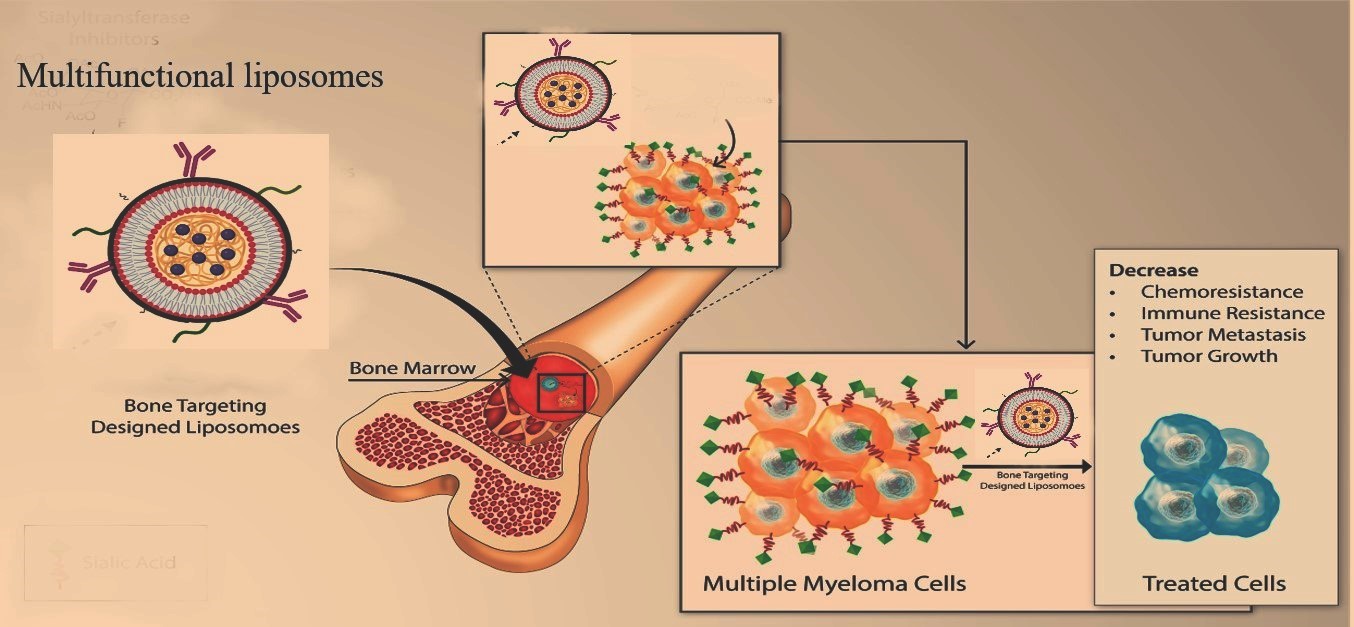Nanomedicine-based targeting therapy could overcome the challenges of multiple myeloma: Novel insight from NanoBio4Can Program
Multiple myeloma (MM) means clonal expansion of malignant B-cell neoplasm characterized by destructive growth of mutated plasma cells within the bone marrow [1]. Multiple myeloma comprises 1% of all cancers worldwide and approximately 10% of all hematologic malignancies [2]. In 2023, an estimated 35,730 persons (19,860 men and 15,870 women) in the United States were recognized to have multiple myeloma, and more than 12,000 patients died from the disease [3]. In the UK, myeloma is the 19th most common cancer diagnosed, with 2% of all new cancer cases (2016-2018). Since 5700 new cases of myeloma are diagnosed in the UK per year, and around 3000 deaths each year [4] . In Ireland, around 380 patients are diagnosed per year. According to the Canadian Cancer Society, 4000 residents were diagnosed with Multiple myeloma in 2022 [5]. In 2016, there were about 130,000 cases of myeloma, translating to an age-standardized incidence rate of 2.1 per 100,000 persons [6]. Multiple myeloma caused 98,437 deaths globally, with an age-standardized incidence ratio of 1.5 per 100,000 persons. Therefore, the incidence cases of myeloma increased globally from 1990 to 2016 by 126% and the percentage of patients who died from myeloma reached 94% [7]. In Turkey, the incidence is approximately four cases per 100,000 people. An average of around three thousand multiple myeloma diagnoses are made each year [8]. The current clinical treatment options for MM are limited to radio- and chemotherapy (principally bortezomib) regimens after surgical resection; however, recurrence is almost inevitable [9]. Various factors, including soluble substances, physical contact between myeloma cells and stromal cells, and interactions with the extracellular matrix of the bone marrow, may influence the survival and growth of multiple myeloma (MM) [10]. For instance, IL-6 secreted by stromal cells has been demonstrated as a survival molecule for multiple myeloma through cell surface mediators such as CD56, fibronectin, and particularly CD44 [11]. Numerous nanoparticle platforms have been produced over the past few decades, including liposomes, polymer micelles, organic polymers, and mesoporous silica [12]. These thorough investigations have aided in the successful clinical implementation of numerous nanotherapeutics since the Food and Drug Administration (FDA) approved the liposomal medication doxorubicin (brand name: Doxil) in 1995 [13]. However, the best nanotherapeutics have yet to be fully utilized, and each delivery method currently available has some drawbacks. Due to their unique advantages, such as their inherent biodegradability, a mesoporous structure that can load a variety of therapeutic or imaging molecules, and diverse components in both metal ions and organic ligands to render them versatile functionalities in a single system, nanoscale coordination polymers have recently demonstrated great potential in the biomedical field [14]. The first innovative aspect of our project is to synthesize and optimize the novel liposomal (NPs) to target multiple myeloma.

Figure 1: Illustrates a functionalized liposome that targets multiple myeloma
References
- Parikh RH, Lonial S. Chimeric antigen receptor T-cell therapy in multiple myeloma: A comprehensive review of current data and implications for clinical practice. CA Cancer J Clin. 2023 May-Jun;73(3):275-285.
- Cowan AJ, Green DJ, Kwok M, Lee S, Coffey DG, Holmberg LA, Tuazon S, Gopal AK, Libby EN. Diagnosis and Management of Multiple Myeloma: A Review. JAMA. 2022 Feb 1;327(5):464-477.
- Bird SA, Boyd K. Multiple myeloma: an overview of management. Palliat Care Soc Pract. 2019 Oct 9;13:1178224219868235.
- Hesketh SJ. Advancing cancer cachexia diagnosis with -omics technology and exercise as molecular medicine. Sports Med Health Sci. 2024 Jan 28;6(1):1-15.
- Monteith BE, Sandhu I, Lee AS. Management of Multiple Myeloma: A Review for General Practitioners in Oncology. Curr Oncol. 2023 Apr 22;30(5):4382-4401.
- Ternák G, Berényi K, Németh B, Szenczi Á, Márovics G, Kiss I. Association of antibiotic-consumption patterns with the prevalence of hematological malignancies in European countries. Sci Rep. 2022 May 12;12(1):7821.
- Turesson I, Bjorkholm M, Blimark CH, Kristinsson S, Velez R, Landgren O. Rapidly changing myeloma epidemiology in the general population: Increased incidence, older patients, and longer survival. Eur J Haematol. 2018 Apr 20:10.1111/ejh.13083.
- https://www.anadolumedicalcenter.com/health-guide/multiple-myeloma
- Modvig S, Jeyakumar J, Marquart HV, Christensen C. Integrins and the Metastasis-like Dissemination of Acute Lymphoblastic Leukemia to the Central Nervous System. Cancers (Basel). 2023 Apr 27;15(9):2504.
- García-Sánchez D, González-González A, Alfonso-Fernández A, Del Dujo-Gutiérrez M, Pérez-Campo FM. Communication between bone marrow mesenchymal stem cells and multiple myeloma cells: Impact on disease progression. World J Stem Cells. 2023 May 26;15(5):421-437.
- Wang AZ, Langer R, Farokhzad OC. Nanoparticle delivery of cancer drugs. Annu Rev Med. 2012;63:185-98. doi: 10.1146/annurev-med-040210-162544.
- Cao J, Huang D, Peppas NA. Advanced engineered nanoparticulate platforms to address key biological barriers for delivering chemotherapeutic agents to target sites. Adv Drug Deliv Rev. 2020 Dec;167:170-188.
- Barenholz Y. Doxil®--the first FDA-approved nano-drug: lessons learned. J Control Release. 2012 Jun 10;160(2):117-34.
- Zhong L, Li Y, Xiong L, Wang W, Wu M, Yuan T, Yang W, Tian C, Miao Z, Wang T, Yang S. Small molecules in targeted cancer therapy: advances, challenges, and future perspectives. Signal Transduct Target Ther. 2021 May 31;6(1):201
Author: Nemany Abdelhamid Nemany Hanafy, PhD
NanoBio4Can MSCA Co-Fund Fellow
Koç University Translational Medicine Research Center (KUTTAM)